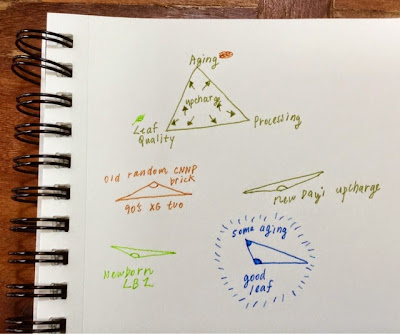I've been aging sheng for nine years and on bad days I curse with both fists the lameness of natural Berkeley storage. Just think- if Bay Area storage was anything special- that David Hoffman would be making hand over fist right now. His hoard of "last millennium" sheng aged in his Marin hideaway would be in great demand. In drinking several 90's sheng from Kunming, Kunming storage does not seem to me that much better either. Some drinkers may hold onto the fantasy of extra dry storage and slow aging producing more interesting teas. I've gotten over such wishful notions and now have to deal with the implications.
My house is on average 55-65%RH and it's perfectly comfortable for humans. It's moist enough to cause mold problems in some of my antique rosewood and teak furniture but it's not enough for sheng to happily ferment. It's more of the double whammy of cold and dry as it rarely breaks over 75F. For a while, I held onto that last refuge that my teas were in the "awkward phase" between youth and age where they can go a bit flat and quiet. I've got my tweens and also the 90's samples from Phoenix Collection Emmett sent me so I know it's not going to magically get that much better in the next five years.
I've been surprised by lower quality leaf that a little humid storage has made into something more interesting. I have high quality leaf that has just flattened out or has barely aged here. I initially did not appreciate mildly wet stored/humid stored cakes because I was used to drinking dry stored. I've come around as the livelier mouth feel and depth of humid storage is superior to dry climate dry storage.
I am following Plan B- get more mid-range cakes that have had 5+ years in a humid zone. I really kick myself for holding out for so long. The most affordable humid stored cakes available to me currently are the ebay vendors out of Guangzhou and prices appear to have leapt double in the last two years.
In browsing through pre 2006 sheng for the most reputable Guangzhou ebay vendors Red Lantern Tea and RJ Teahouse carry mostly big factory goods with no shortage of overpriced Dayi; Red Lantern Tea which has a better selection does not do samples. I get a sample of the truly gentle beeng- 2006 Mengku Gu Hua- double whammy of autumnal and weakened by humid storage.
More gentler is the
2005 Mengku Spring Tips for $67.80. There's nothing more galling than seeing the ebay purchase history with some lucky dog buying this for $29.50 back in Nov. 2011. I remember this very beeng going around $16(probably cheaper) back in 2006. I used to have an unjustified prejudice against Lincang sweetness in sheng back then and so did not bother even with a sample beeng.
It would make better sense to get a twin of something I already have. However I can't quite force myself to spend 4x for a mediocre plantation factory tea I already dislike and none of my good cakes are even listed. After much deliberation, I settle on a
2006 Changtai Lao Chen Nannuo from the Old "Man" Chen series. Don't groan, I have my reasons:
- vendor description says "floral and soft" - "soft" is vendor speak for weak-assed and I apparently love the gentle caresses of a mild mannered tea. Probably this is why I am drawn to Nannuos in the first place.
- see how a mediocre factory tea improves with 8+ years humid storage.
- compare against my supposed old tree Nannuos from 2004-2006
- compare against my other Changtai cakes
Lao Chen is supposed to be named after Changtai board chairman and really for $9.50-$11 a beeng for the 2005 versions I paid, it's decent.
I just bought a few starter humid stored cakes to see if I should ramp it up. I'm also looking at a few Guangzhou aged shu wondering if it's worth sinking yet more money into shu.
(It will take at least a week for these teas to arrive. )






























